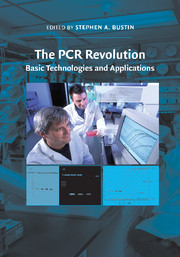Book contents
- Frontmatter
- Contents
- Contributors
- Foreword by Russell Higuchi
- Preface
- I BASIC TECHNOLOGIES
- II APPLICATIONS
- 10 Polymerase chain reaction–based methods for the detection of solid tumor cancer cells for clinical diagnostic and prognostic assays
- 11 Polymerase chain reaction and infectious diseases
- 12 Polymerase chain reaction and respiratory viruses
- 13 Polymerase chain reaction and severe acute respiratory syndrome
- 14 The MMR vaccine, measles virus, and autism – A cautionary tale
- 15 Noninvasive prenatal diagnosis using cell-free fetal nucleic acids in maternal plasma
- 16 Polymerase chain reaction–based analyses of nucleic acids from archival material
- 17 Microarrays and quantitative real-time reverse transcriptase–polymerase chain reaction
- 18 Polymerase chain reaction in the detection of genetic variation
- 19 Polymerase chain reaction: A blessing and a curse for ancient deoxyribonucleic acid research
- Index
- Plate section
- References
17 - Microarrays and quantitative real-time reverse transcriptase–polymerase chain reaction
Published online by Cambridge University Press: 25 January 2011
- Frontmatter
- Contents
- Contributors
- Foreword by Russell Higuchi
- Preface
- I BASIC TECHNOLOGIES
- II APPLICATIONS
- 10 Polymerase chain reaction–based methods for the detection of solid tumor cancer cells for clinical diagnostic and prognostic assays
- 11 Polymerase chain reaction and infectious diseases
- 12 Polymerase chain reaction and respiratory viruses
- 13 Polymerase chain reaction and severe acute respiratory syndrome
- 14 The MMR vaccine, measles virus, and autism – A cautionary tale
- 15 Noninvasive prenatal diagnosis using cell-free fetal nucleic acids in maternal plasma
- 16 Polymerase chain reaction–based analyses of nucleic acids from archival material
- 17 Microarrays and quantitative real-time reverse transcriptase–polymerase chain reaction
- 18 Polymerase chain reaction in the detection of genetic variation
- 19 Polymerase chain reaction: A blessing and a curse for ancient deoxyribonucleic acid research
- Index
- Plate section
- References
Summary
Since the introduction of gene expression microarray technology, the number of applications and publications based on it has grown enormously. Nowadays, there is almost no institution or university in the field of molecular biology that has no genomic facility helping to apply this technique. Microarrays, an ordered assembly of thousands of probes, have the ability to allow the simultaneous determination of the expression levels of thousands of genes. This technique was used to describe gene programs that underlie various cellular processes, such as immunity and hormone responses, as well as to refine classifications of neoplasias, and to define diagnostic molecular markers for diseases. However, one drawback of the microarray technique is that, the more genes are tested, the higher the risk of identifying false positives as a result of random effects. Furthermore, biological and technical variations, including the microarray design, can affect the precision of microarray results. More difficult situations are found when working with complex multicellular tissue samples as compared to cell line experiments. The outcome of these microarray experiments can result in low fold changes and low signal intensities for differentially expressed genes, which makes it difficult to detect regulated genes reliably. Therefore, the identification of differentially expressed genes requires independent confirmation. Quantitative real-time reverse transcriptase–polymerase chain reaction (qPCR) is the method of choice because of its broad range of linearity, high sensitivity, and reproducibility and because it can be easily adapted to test several hundreds of transcripts.
- Type
- Chapter
- Information
- The PCR RevolutionBasic Technologies and Applications, pp. 262 - 275Publisher: Cambridge University PressPrint publication year: 2009



